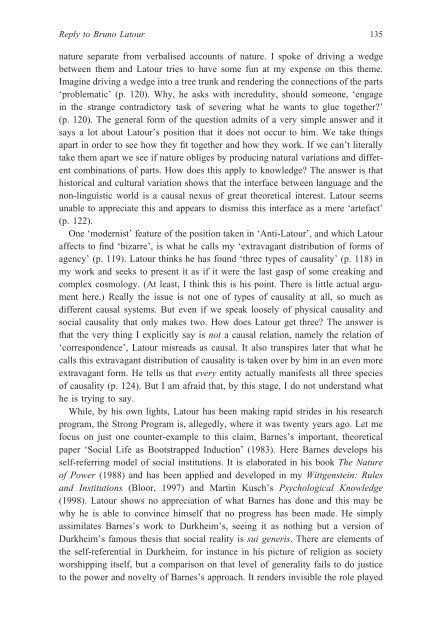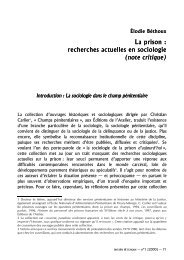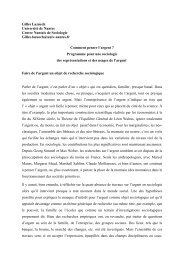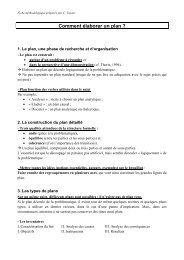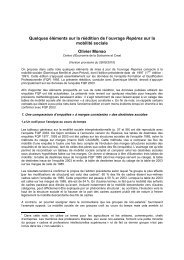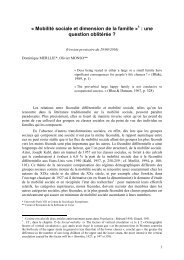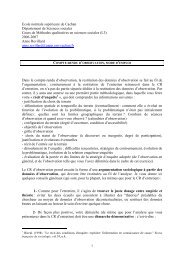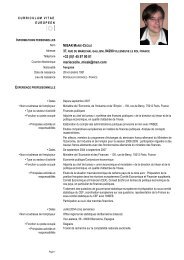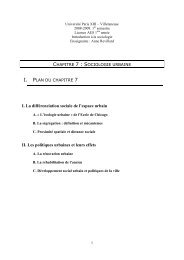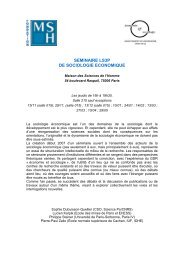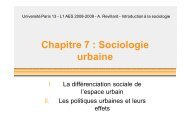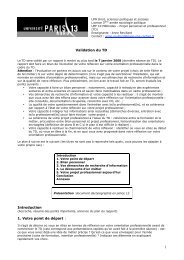DISCUSSION Reply to Bruno Latour David Bloor* - Melissa
DISCUSSION Reply to Bruno Latour David Bloor* - Melissa
DISCUSSION Reply to Bruno Latour David Bloor* - Melissa
Create successful ePaper yourself
Turn your PDF publications into a flip-book with our unique Google optimized e-Paper software.
<strong>Reply</strong> <strong>to</strong> <strong>Bruno</strong> La<strong>to</strong>ur135nature separate from verbalised accounts of nature. I spoke of driving a wedgebetween them and La<strong>to</strong>ur tries <strong>to</strong> have some fun at my expense on this theme.Imagine driving a wedge in<strong>to</strong> a tree trunk and rendering the connections of the parts‘problematic’ (p. 120). Why, he asks with incredulity, should someone, ‘engagein the strange contradic<strong>to</strong>ry task of severing what he wants <strong>to</strong> glue <strong>to</strong>gether?’(p. 120). The general form of the question admits of a very simple answer and itsays a lot about La<strong>to</strong>ur’s position that it does not occur <strong>to</strong> him. We take thingsapart in order <strong>to</strong> see how they fit <strong>to</strong>gether and how they work. If we can’t literallytake them apart we see if nature obliges by producing natural variations and differentcombinations of parts. How does this apply <strong>to</strong> knowledge? The answer is thathis<strong>to</strong>rical and cultural variation shows that the interface between language and thenon-linguistic world is a causal nexus of great theoretical interest. La<strong>to</strong>ur seemsunable <strong>to</strong> appreciate this and appears <strong>to</strong> dismiss this interface as a mere ‘artefact’(p. 122).One ‘modernist’ feature of the position taken in ‘Anti-La<strong>to</strong>ur’, and which La<strong>to</strong>uraffects <strong>to</strong> find ‘bizarre’, is what he calls my ‘extravagant distribution of forms ofagency’ (p. 119). La<strong>to</strong>ur thinks he has found ‘three types of causality’ (p. 118) inmy work and seeks <strong>to</strong> present it as if it were the last gasp of some creaking andcomplex cosmology. (At least, I think this is his point. There is little actual argumenthere.) Really the issue is not one of types of causality at all, so much asdifferent causal systems. But even if we speak loosely of physical causality andsocial causality that only makes two. How does La<strong>to</strong>ur get three? The answer isthat the very thing I explicitly say is not a causal relation, namely the relation of‘correspondence’, La<strong>to</strong>ur misreads as causal. It also transpires later that what hecalls this extravagant distribution of causality is taken over by him in an even moreextravagant form. He tells us that every entity actually manifests all three speciesof causality (p. 124). But I am afraid that, by this stage, I do not understand whathe is trying <strong>to</strong> say.While, by his own lights, La<strong>to</strong>ur has been making rapid strides in his researchprogram, the Strong Program is, allegedly, where it was twenty years ago. Let mefocus on just one counter-example <strong>to</strong> this claim, Barnes’s important, theoreticalpaper ‘Social Life as Bootstrapped Induction’ (1983). Here Barnes develops hisself-referring model of social institutions. It is elaborated in his book The Natureof Power (1988) and has been applied and developed in my Wittgenstein: Rulesand Institutions (Bloor, 1997) and Martin Kusch’s Psychological Knowledge(1998). La<strong>to</strong>ur shows no appreciation of what Barnes has done and this may bewhy he is able <strong>to</strong> convince himself that no progress has been made. He simplyassimilates Barnes’s work <strong>to</strong> Durkheim’s, seeing it as nothing but a version ofDurkheim’s famous thesis that social reality is sui generis. There are elements ofthe self-referential in Durkheim, for instance in his picture of religion as societyworshipping itself, but a comparison on that level of generality fails <strong>to</strong> do justice<strong>to</strong> the power and novelty of Barnes’s approach. It renders invisible the role played


